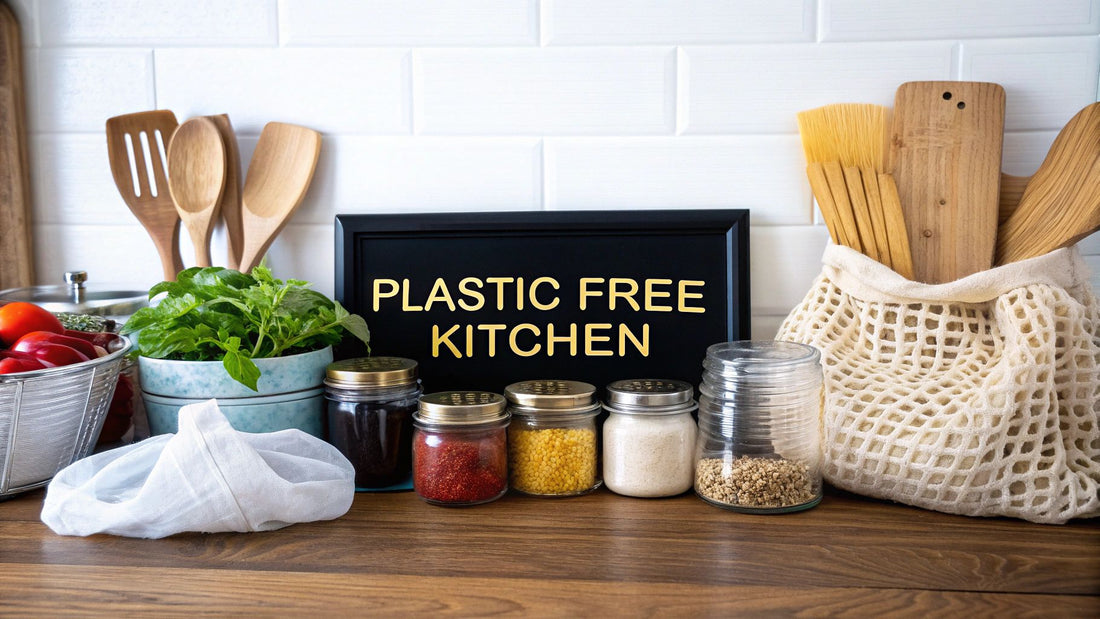
Plastic Free Kitchen: Easy Tips to Transform Your Space
Share
Why Your Kitchen Transformation Matters More Than You Think
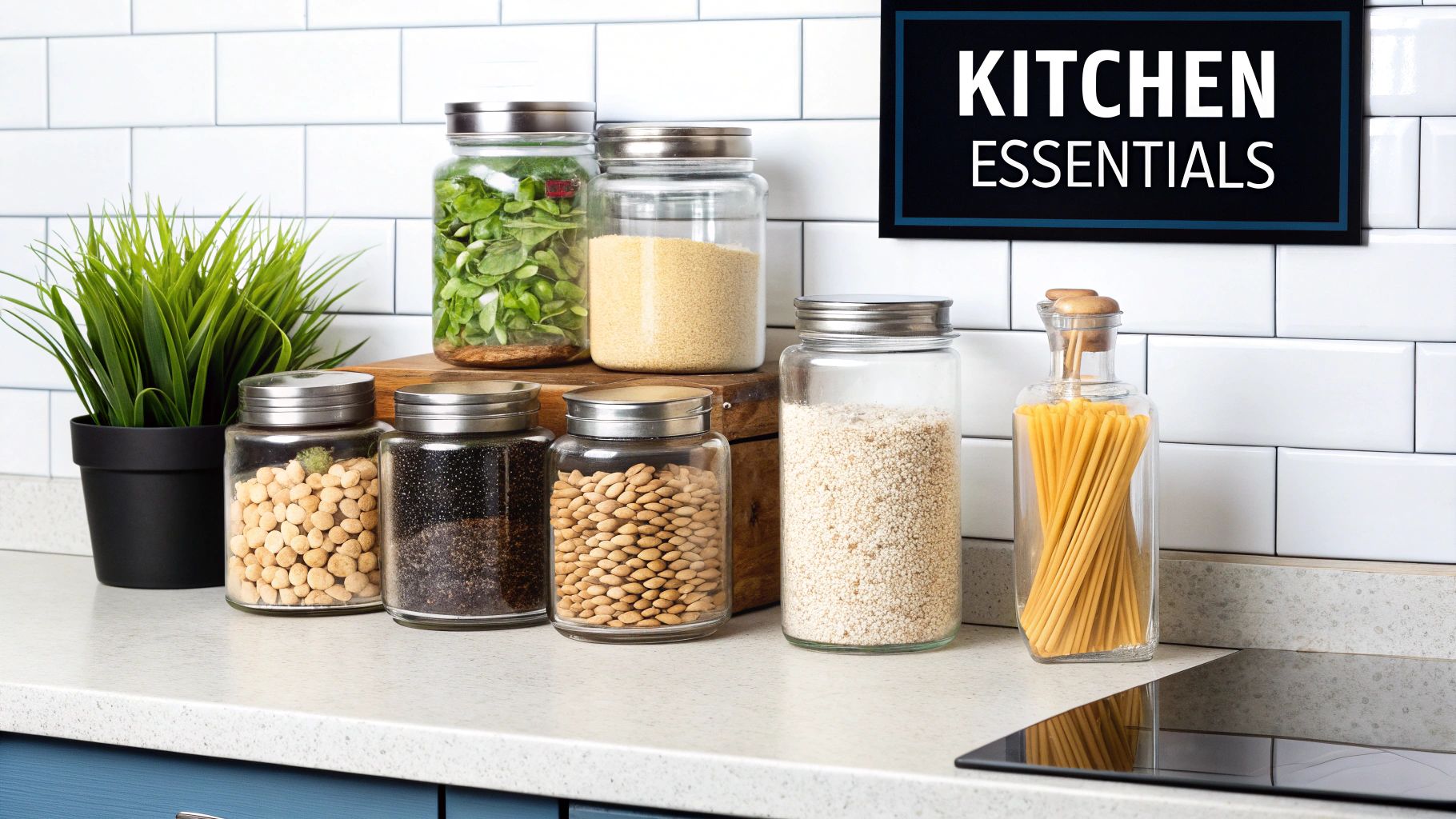
Let's be honest, kitchen plastic can be insidious. It's not just the obvious things like single-use grocery bags and takeout containers. It's also the slow, almost invisible buildup of chemicals that leach from those plastic storage containers, especially when you heat them up.
I've chatted with a lot of families who are making the switch to a plastic-free kitchen, and what's interesting is that their motivations often go beyond just helping the environment. They’re also really concerned about the potential health impacts on their kids and themselves.
Think about this common scenario: you're reheating leftovers in a plastic container in the microwave. Seems harmless enough, right? But actually, this can release chemicals like BPA and phthalates right into your food. I've spoken with so many people who were totally unaware of this! They were really surprised, even shocked, when they learned about the possible health risks. And for many, that’s what really motivates them to ditch the plastic.
The good news is creating a plastic-free kitchen isn't the huge challenge it used to be. There are so many great sustainable alternatives now, from glass and stainless steel containers to reusable wraps and bags. Seriously, the options are exploding!
Plastic-Free Living: A Growing Global Movement
This shift isn't just happening in individual kitchens. We're seeing a global push towards plastic-free living, which makes transitioning so much easier and more accessible. Trust me, you're not alone in this, and it's absolutely not too late to start.
The global plastic crisis is a huge problem, and our kitchens are definitely part of it. Think about how much of the food we buy comes wrapped in plastic. It's estimated that over 8 million tonnes of plastic waste ends up in our oceans every year. This has devastating consequences for marine life and even contaminates our food systems.
But things are changing. The plastic-free packaging market is rapidly expanding. It’s projected to jump from $6.04 billion in 2024 to $6.64 billion in 2025, a compound annual growth rate (CAGR) of 9.9%. Here's some more data on the growth of the plastic-free packaging market. Creating a plastic-free kitchen is more than a personal choice; it's a way to join a bigger movement for a healthier planet and a healthier you.
Smart Storage Swaps That Actually Work in Real Kitchens
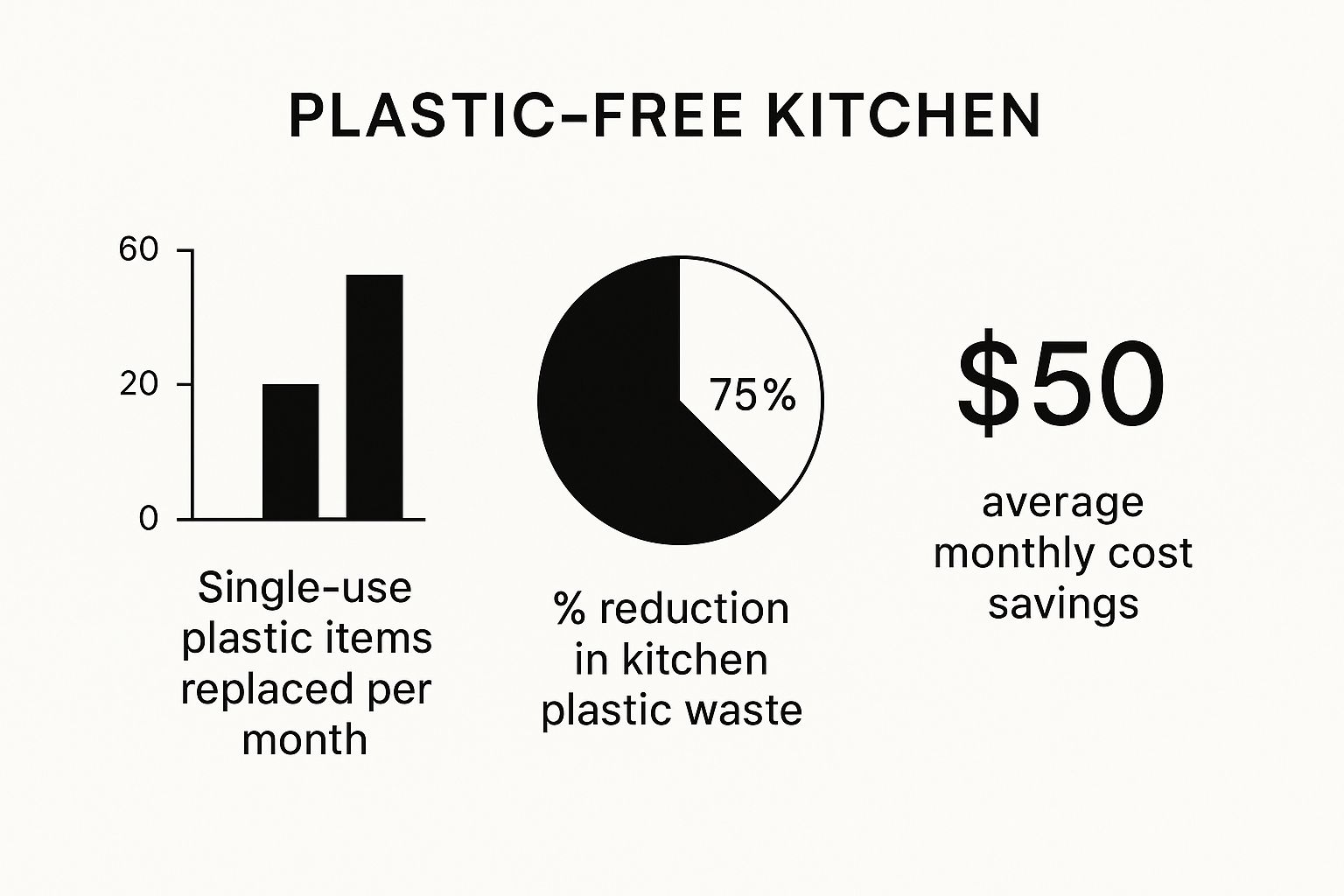
The infographic above gives you a visual snapshot of what ditching plastic in your kitchen can really do. It shows how many single-use plastic items get replaced each month, the total drop in plastic waste, and even how much money you can typically save. It's pretty impressive to see how even little changes add up to make a big difference for both the planet and your wallet! Families who have made the switch are seeing real savings and way less plastic piling up. It just goes to show how practical sustainable choices can be.
Going plastic-free doesn't mean tossing everything out at once. Honestly, that can be overwhelming. Instead, think about the plastic items you use the most. Those go-to containers you're always grabbing for leftovers or packing lunches? Those are perfect starting points for upgrading to durable, sustainable alternatives.
Glass: A Versatile But Sometimes Tricky Choice
Glass is awesome! Oven-safe, freezer-safe, microwave-safe – talk about versatile. But there's a catch: not all glass is made equal. I've seen friends buy beautiful glass containers, only to have them shatter from a sudden temperature change. It's such a waste! My advice? Look for borosilicate glass. It's specifically designed to handle those extreme temperature swings.
Stainless Steel: The Workhorse of a Plastic-Free Kitchen
Stainless steel is another great option, especially for storing dry goods and non-acidic foods. It's practically indestructible! But here's a little tip: acidic foods like tomato sauce can react with lower-quality stainless steel and mess with the flavor. Go for food-grade stainless steel to avoid that issue. Creating a plastic-free kitchen is a huge step towards reducing global plastic waste. One of the most impactful ways to do this is by simply saying no to single-use plastics. Imagine if every household in the U.S. swapped plastic water bottles for reusable ones. We'd be saving millions of plastic bottles from landfills and oceans. Using sustainable options like glass and stainless steel containers for food storage makes a massive dent in your waste, too. Discover more insights on sustainable kitchen practices here.
Starting Small and Building Your Collection
The people I’ve seen have the most success with this go plastic-free gradually. They start by replacing the plastic items they use most often and slowly build their collection of sustainable alternatives over time. It’s much more manageable and less daunting than trying to do everything at once. Plus, it gives you a chance to try different containers and materials to find what really works for your cooking style and how you use your kitchen. It’s a journey, not a sprint!
To help you choose the right materials, here’s a handy comparison:
Container Material Comparison for Kitchen Storage This table compares glass, stainless steel, and plastic containers based on safety, durability, cost, and their environmental impact. It’ll give you a quick overview of the pros and cons of each material.
| Material | Food Safety | Durability | Cost | Environmental Impact | Best Uses |
|---|---|---|---|---|---|
| Glass | Excellent – doesn't leach chemicals | Good, especially borosilicate glass, but can break | Moderate | Very good, recyclable | Leftovers, storing liquids, baking (borosilicate) |
| Stainless Steel | Excellent for non-acidic foods; lower quality can react with acidic foods | Excellent, very durable | High | Excellent, recyclable and long-lasting | Dry goods, non-acidic foods, travel |
| Plastic | Varies greatly depending on plastic type; some can leach chemicals | Varies greatly, can become brittle or warped over time | Low | Negative, contributes to plastic pollution, not always easily recyclable | Limited uses in a plastic-free kitchen; consider phasing out |
As you can see, each material has its strengths and weaknesses. Glass is great for visibility and food safety, while stainless steel wins for durability. Plastic, while often the cheapest, comes with environmental downsides. Choosing the right container depends on what you’re storing and how you plan to use it.
Grocery Shopping Without The Plastic Struggle
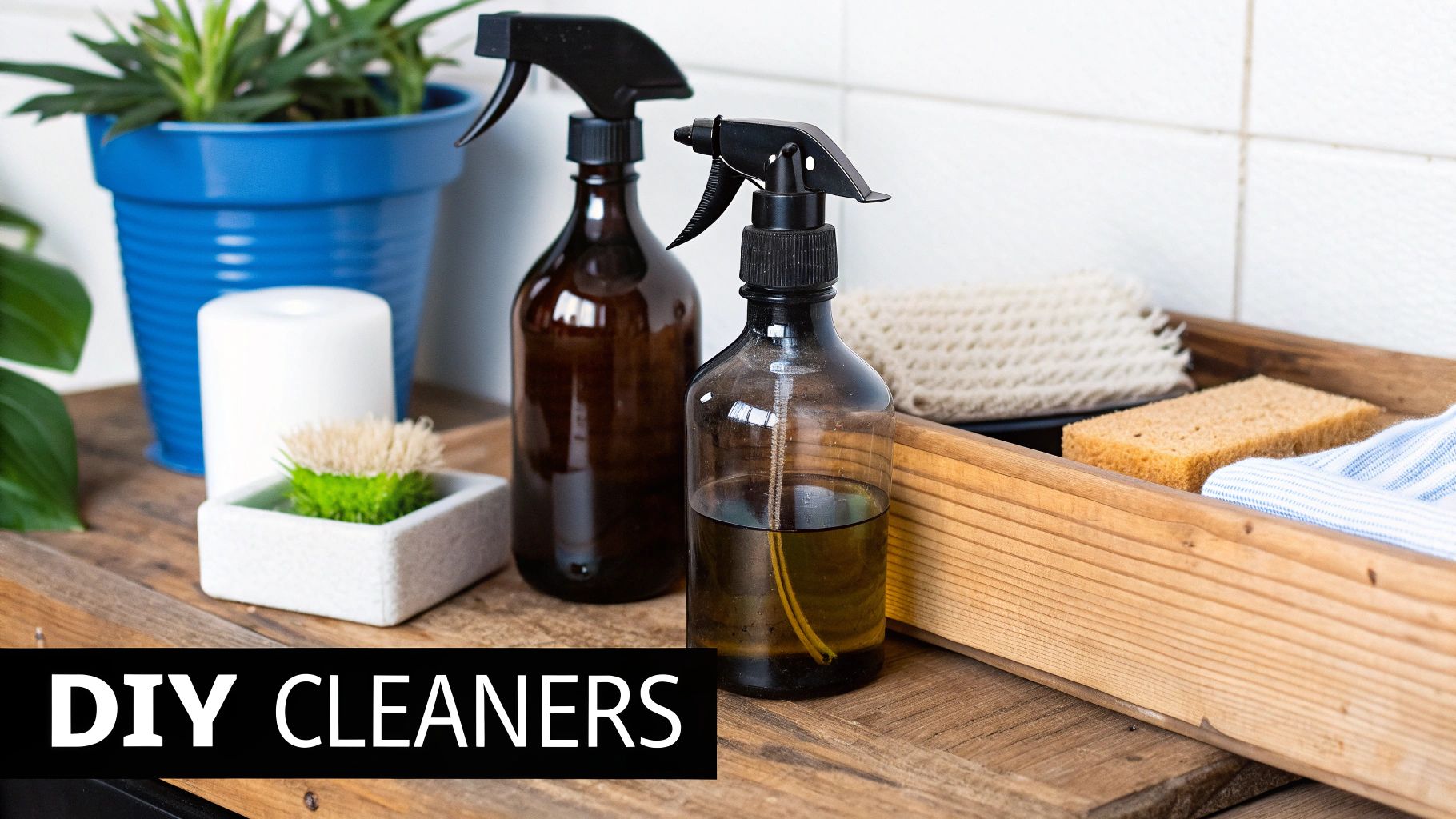
Creating a plastic-free kitchen isn't just about swapping containers; it's a whole new way of thinking about grocery shopping. Honestly, the idea of navigating a supermarket without grabbing plastic-wrapped everything felt daunting at first. But with a little planning and some new strategies, it’s not only manageable, it’s actually kind of fun!
Finding Your Plastic-Free Allies in the Grocery Aisles
The first challenge is finding stores that support your plastic-free mission. Some grocery chains are definitely better than others. My advice? Don’t be shy! Talk to the store manager. I was surprised how helpful some managers were. Once I explained my goal, they were happy to point out bulk bin options and even offered tips for shopping with my own reusable containers.
Conquering the Bulk Bins (and Other Plastic-Free Shopping Strategies)
Bulk bins used to intimidate me too. Remembering the codes, weighing things, making sure my containers were clean...it felt overwhelming. But trust me, it gets easier! My tip is to start small. Pick a few staples you buy regularly and get comfortable with the bulk bin process. Building a relationship with the staff can also be a game-changer. They can offer advice on the best products and help you navigate the bulk section.
Buying loose food and using your own containers is key to a plastic-free kitchen. It not only reduces plastic waste but supports sustainable food systems, too. Think about it: buying loose produce significantly cuts down on plastic packaging. Discover more insights on sustainable packaging here. Beyond bulk bins, check out your local farmers markets and vendors. They're often more open to reusable containers.
Meal Planning: Your Secret Weapon for a Plastic-Free Kitchen
Meal planning is a lifesaver when you're going plastic-free. It's not about strict recipes, but planning your meals around what's available without plastic. Ironically, I've found this makes cooking more creative and encourages me to cook with what’s in season. Plus, it makes shopping so much easier since I know exactly what I need.
Building Relationships With Local Vendors
Local vendors are your friends! Farmers markets, butchers, and specialty stores are often happy to accommodate reusable containers. The key is communication. Instead of showing up with containers and hoping for the best, talk to them! Explain why you're trying to reduce plastic and ask how they prefer to handle reusable containers. This builds a good relationship and makes the process smoother for everyone. From conquering those bulk bins to connecting with local vendors, these little steps can transform grocery shopping. Instead of being a source of plastic overload, it becomes a positive step toward a more sustainable kitchen and a healthier planet.
Pantry Organization That Keeps Food Fresh Without Plastic
Switching to a plastic-free pantry might seem like a big change in how you store your food, but honestly, the rewards are so worth it. I've chatted with lots of families who’ve ditched plastic, and they all agree: good organization becomes even more critical when you're using glass jars and reusable cloth bags. It's all about keeping your food fresh and easy to find, so you avoid waste and those "I can't find anything in this pantry!" moments.
Matching Storage Methods to Food Types
Here’s the thing: different foods have different storage needs. What works for your grains won't necessarily work for dried fruit, and fresh produce is a whole different ball game. This is where it can get a little interesting. For example, popping dried fruit into airtight glass jars keeps them from getting all dry and hard (nobody wants that!). But those same airtight containers can spell disaster for fresh produce, trapping moisture and speeding up spoilage. Instead, try breathable containers like cotton produce bags or those handy reusable mesh bags for your fruits and veggies.
Remember those classic food preservation techniques, like keeping dried beans in airtight containers in a cool, dark spot? They work amazingly well in a modern plastic-free kitchen. In fact, these tried-and-true methods often keep food fresher than plastic wrap ever could. The real trick is knowing which storage solution best suits each type of food. To help you out, I’ve put together a handy table:
To make this whole process a bit easier, I've created a table to guide you:
Plastic-Free Food Storage Solutions by Food Type Matching different food categories with their optimal plastic-free storage methods and container types
| Food Category | Best Container Type | Storage Location | Shelf Life | Special Considerations |
|---|---|---|---|---|
| Dried Beans | Airtight Glass Jar | Cool, Dark Pantry | 1-2 Years | Check for weevils occasionally |
| Grains (Rice, Oats, etc.) | Airtight Glass Jar | Cool, Dark Pantry | 6-12 Months | May need freezing to kill any larvae present in grains |
| Dried Fruit | Airtight Glass Jar | Cool, Dark Pantry | 6-12 Months | Can be stored in the refrigerator for longer shelf life |
| Nuts & Seeds | Airtight Glass Jar | Cool, Dark Pantry or Refrigerator | 3-6 Months | Storing in the refrigerator extends freshness |
| Fresh Produce (Leafy Greens) | Reusable Mesh or Cotton Bags | Refrigerator Crisper | 1-2 Weeks | Store unwashed to prevent premature spoilage |
| Fresh Produce (Root Vegetables) | Basket or open container | Cool, Dark Pantry | 2-4 Weeks | Avoid washing until ready to use |
| Flour | Airtight Glass Jar or Container | Cool, Dark Pantry | 6-8 Months | Freezing can extend shelf life and prevent pests |
| Spices | Airtight Glass Jars | Cool, Dark Pantry | 1-2 Years | Whole spices last longer than ground |
This table provides a starting point for matching your food with the right storage. Remember, your specific climate and storage conditions can impact shelf life, so always check your food regularly.
Labeling and Rotation Strategies for a Plastic-Free Pantry
Once you’ve got your containers all set, a solid labeling system is a game-changer. Trust me, when everything's in similar-looking jars, you'll be thankful you know what's inside! Skip those cute-but-impractical chalkboard labels that smudge and disappear after a few uses. A better option? Reusable labels that you can easily wipe clean or even a simple label maker with clear, easy-to-read text. It’s all about making finding your ingredients a breeze.
And don't forget about rotation strategies – using the older items before the new ones. This is a must for minimizing food waste, especially in a plastic-free pantry where you're more likely to buy in bulk. One easy way to rotate your stock is to place newer items behind older ones on your shelves. This way, you'll naturally grab the food that needs to be used up first.
Space-Saving Tips for Small Kitchens
If you're working with a smaller kitchen, I know how precious every inch of space is. This is where choosing multi-purpose containers really shines. Stackable glass jars are your best friend, helping you maximize vertical space. Also, clear containers are a great idea – you can easily see what you have without having to pull everything out. This not only saves space but also prevents you from accidentally buying something you already have. With a little planning, a plastic-free pantry can be both practical and stylish, no matter the size of your kitchen.
Cooking Tools That Outperform Their Plastic Counterparts
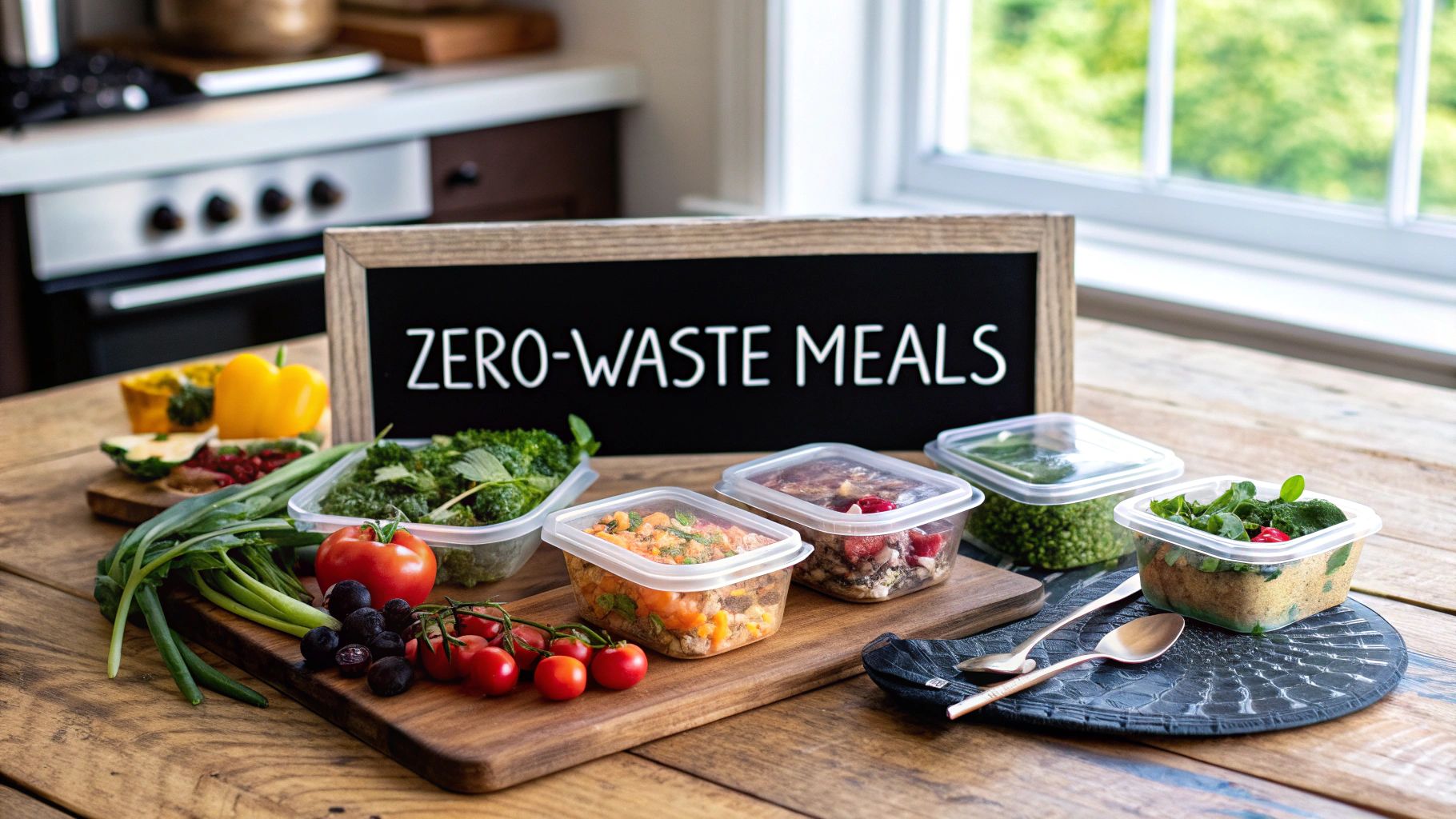
Honestly, one of the biggest and most pleasant surprises on my journey to a plastic-free kitchen has been the performance of the alternative cooking tools. I started out pretty hesitant. Would a wooden spoon really hold up to daily use? Were bamboo spatulas going to be too flimsy? Turns out, I was worried for nothing.
Let me tell you, a good quality wooden spoon, especially olivewood or maple, develops this gorgeous patina over time. And that patina isn't just pretty. It actually creates a naturally non-stick surface. I'm constantly amazed at how easily food just slides off! Bamboo utensils are another revelation. They're so lightweight and comfortable in your hand, plus they're incredibly strong and durable. Mine have survived some seriously vigorous stirring and flipping.
Choosing the Right Materials for Different Cooking Methods
The real secret to success with plastic-free cooking tools is understanding what materials work best for what you're cooking. Wooden spoons are my go-to for stirring sauces and soups on the stovetop, while a stainless steel whisk is perfect for whipping cream or eggs.
Silicone spatulas, while technically plastic, are a good heat-resistant choice for scraping the bottom of pots and pans. Just be sure to choose high-quality silicone from a reputable brand to minimize any potential chemical leaching.
Investing in Quality for Long-Term Savings
When it comes to stainless steel gadgets like peelers, graters, and can openers, investing in quality will pay off big time. They can last for decades! Sure, the upfront cost might be a bit more than their plastic counterparts, but you'll save so much money in the long run because you won't be constantly replacing them.
I learned this lesson the hard way after buying cheap plastic versions that broke after only a few uses. Trust me, spending a little extra on durable stainless steel is worth every penny.
Adapting Your Meal Prep and Storage
Switching to a plastic-free kitchen does mean changing your meal prep strategies. But the alternatives – glass, stainless steel, and even reusable beeswax wraps – often keep food fresher longer.
And honestly, sometimes going back to traditional methods is the best. Wrapping food in cloth or storing it in glass jars actually preserves flavors better than plastic in many cases. Adapting my favorite recipes to plastic-free storage has been way easier than I thought.
Surprisingly, many dishes even taste better when stored properly in glass or stainless steel, probably because they aren't absorbing any unwanted plastic flavors. That's been a delightful bonus in my plastic-free kitchen journey!
Maintaining Your Plastic-Free Cooking Tools
Of course, proper care and maintenance are key for keeping your plastic-free tools in great shape. Wooden utensils should be hand-washed and oiled occasionally to prevent cracking. Stainless steel can go in the dishwasher, but skip the harsh abrasives that can scratch the surface.
With just a little TLC, these tools will easily outlast multiple sets of their plastic equivalents. You'll quickly get into a routine for cleaning and caring for your tools, making sure they perform at their best for years to come.
Navigating The Challenges Nobody Warns You About
Transitioning to a plastic-free kitchen? It's a marathon, not a sprint. There will be hiccups, and that’s totally okay. The trick is knowing what to expect so you can handle those bumps in the road with grace. Let’s chat about some real-world hurdles you might encounter and how to get past them.
Family Resistance
Getting everyone on board can be… interesting. Kids, in particular, can be attached to their favorite plastic-wrapped snacks or sippy cups. I get it; I’ve been there. The game-changer? Involving everyone in the process. Let them help choose new containers or snacks. Explain why making these changes matters. Turn it into a family project, and suddenly, everyone’s excited and on board.
The "Impossible" Items
Let’s be honest, some things just seem impossible to find without plastic. And sometimes? They are. Don't let these tricky items derail you. Pick your battles. Focus on the swaps you can make and celebrate those wins. For those stubborn plastic-wrapped holdouts? Research alternative brands, or hey, maybe even try making your own!
Freshness and Storage
Remember that feeling of staring blankly into your fridge, wondering how you’ll keep anything fresh without plastic wrap? I do. Turns out, it’s simpler than it seems. Wrap your greens in damp cloths or store them in glass containers with a paper towel. Freezer burn is also something to be mindful of when you ditch plastic freezer bags. Easy fix? Glass containers with a bit of headspace to allow for expansion.
Traveling and Guests
Traveling plastic-free takes a little extra planning. Pack your own snacks and reusable cutlery. When you’re eating out, politely decline plastic straws and utensils. Having guests over who aren't used to a plastic-free lifestyle can feel a bit awkward at first, too. Just be kind and explain your choices without, you know, lecturing. Most people are understanding. You might even inspire them!
The Busy-Life Backslide
Life happens. We all have those weeks where sticking to any kind of routine feels like a pipe dream. Have a backup plan. Keep a stash of reusable containers at the ready. Simplify your meal planning during busy stretches. It’s okay to compromise sometimes, knowing you'll get back on track when things calm down. The biggest thing is building sustainable habits that work for you and your family. This journey is about progress, not perfection.
Your Realistic Roadmap To Plastic-Free Success
Transitioning to a plastic-free kitchen isn't about some instant, magical transformation. It's more about making thoughtful choices, one step at a time, and building habits that actually work with your lifestyle. In my experience, the families who really make this stick long-term start small and focus on areas where they can see a difference quickly—like how they store food and how they shop.
Creating a Phased Approach
Think of it as a journey, not a sprint to the finish line! You don't have to do everything at once. A phased approach keeps you from getting overwhelmed and helps you build momentum. Start by taking stock of your current kitchen. What plastic items are you using constantly? Those are the ones to tackle first. For me, it was plastic wrap—I used it for everything. Switching to beeswax wraps and reusable silicone covers made a huge initial impact.
Setting Realistic Goals and Measuring Progress
Be kind to yourself and set realistic goals. Instead of aiming for a perfectly plastic-free kitchen in a week (it's harder than it sounds!), maybe your first goal is simply getting rid of all your plastic food storage containers. Once you've nailed that down and it feels like second nature, you can move onto another area, like ditching those single-use plastic produce bags at the grocery store.
And measuring progress isn’t just about counting how many plastic items you’ve tossed out. It’s also about noticing the positive changes in your relationship with food and how you cook. I've heard from so many families who’ve found themselves cooking fresher, more seasonal meals and actually enjoying being in the kitchen more. These unexpected perks can be really motivating.
Getting the Whole Family Involved
This is a big one. A plastic-free kitchen works best when everyone is on board. Get your kids involved! Let them pick out new reusable containers or explore the bulk bins at the store. When everyone understands why you're making these changes, they're much more likely to embrace the new routines. It really does make the entire process easier and more sustainable when it’s a shared effort.
Building Lasting Habits (Not Just Rules)
Honestly, building lasting habits is way more important than aiming for unrealistic perfection. It's about creating systems that feel natural, not like a set of strict rules. For example, I keep my reusable shopping bags right by the door, so I literally can't leave the house without them. Prepping snacks in reusable containers ahead of time makes grabbing a healthy, plastic-free snack super easy. Little strategies like these fit seamlessly into your daily routine and make a world of difference.
Troubleshooting and Staying Motivated
There will be bumps in the road. You’ll forget your reusable produce bags or get takeout in a plastic container. It happens! Don't beat yourself up about it. The important thing is having ways to handle those hiccups and stay motivated. Forgot your produce bags? Buy your produce loose and put it into your reusable bags when you get home. Simple.
Celebrate the small victories! Acknowledge your progress and remember how far you've come. This will help you keep your spirits up when things get challenging. The goal isn't to become some kind of plastic-free superhero overnight. It's about making gradual, sustainable changes that have a real impact, inspiring others by what you do, not just what you say.
Ready to start stocking your plastic-free pantry the easy way? Check out Naked Pantry for a convenient way to get pantry staples delivered without all the plastic packaging.
